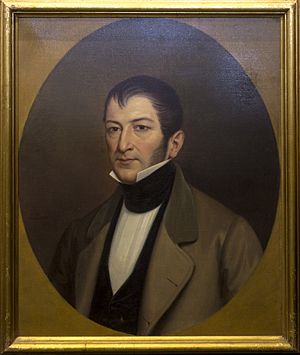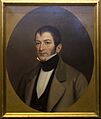Nicolás Bravo facts for kids
Quick facts for kids
Nicolás Bravo
|
|
|---|---|
 |
|
| 11th President of Mexico | |
| In office 10 July 1839 – 19 July 1839 |
|
| Preceded by | Antonio López de Santa Anna |
| Succeeded by | Anastasio Bustamante |
| In office 26 October 1842 – 14 May 1843 |
|
| Preceded by | Antonio López de Santa Anna |
| Succeeded by | Antonio López de Santa Anna |
| In office 28 July 1846 – 4 August 1846 |
|
| Vice President | Himself |
| Preceded by | Mariano Paredes |
| Succeeded by | José Mariano Salas |
| Vocal of the Regence of the Mexican Empire |
|
| In office 11 April 1822 – 18 May 1822 |
|
| 1st Vice President of United Mexican States | |
| In office 10 October 1824 – 23 December 1827 |
|
| President | Guadalupe Victoria |
| Succeeded by | Anastasio Bustamante |
| 4th Vice President of Mexican Republic | |
| In office 12 June 1846 – 6 August 1846 |
|
| President | Mariano Paredes Himself |
| Preceded by | Antonio Lopez de Santa Anna |
| Succeeded by | Valentín Gómez Farías |
| Personal details | |
| Born | 10 September 1786 Chichihualco, Guerrero, New Spain |
| Died | 22 April 1854 (aged 67) Chilpancingo, Guerrero (now Mexico) |
| Political party | Centralist |
Nicolás Bravo (born September 10, 1786 – died April 22, 1854) was an important Mexican soldier and politician. He first became famous during the Mexican War of Independence. He later served as Mexico's first Vice President.
Bravo also served as interim (temporary) president of Mexico three different times. These were in 1839, 1842, and 1846. During his second time as president, he helped change Mexico's constitution. He also led Mexican forces during the Mexican–American War at the Battle of Chapultepec.
Contents
Early Life and Military Service
Nicolás Bravo was born on September 10, 1786, in Chilpancingo. He came from a wealthy family. When the Mexican War of Independence began in 1810, he joined the fight. His father and brother also joined the rebels.
Bravo first served under his father. After two years, he led his own group of soldiers. They went to the province of Veracruz and took control of Coscomatepec. He won a battle at Palma. Sadly, his father was later captured and died. Bravo became known for being kind. He released 300 royalist prisoners, showing mercy.
In 1817, Bravo was captured in the south of Mexico. He was sent to the capital and stayed in prison for three years. He was set free in 1820.
He then joined Agustín de Iturbide's Plan of Iguala in 1821. This plan helped Mexico gain independence. Iturbide made him a colonel. Bravo also became part of the council that governed Mexico before Iturbide became Emperor.
Fighting for a New Mexico
When Iturbide became too powerful, Bravo decided to fight against the government again. He left Mexico City in January 1823. He joined Vicente Guerrero to start a revolution in the south. They carried a copy of the Plan of Vera Cruz, which called for Iturbide to step down.
Bravo and Guerrero faced a tough fight. They were defeated in a skirmish near Almolonga. Guerrero was badly hurt. Bravo managed to escape and tried to gather more troops. He later joined other leaders who wanted to change the government. Iturbide eventually gave up his power. Bravo was chosen to escort Iturbide.
Leading the New Republic
After Iturbide was removed, Bravo became a member of the Supreme Executive Power. This group acted as the government's leaders. During this time, he helped bring peace to the country. He also led a successful military campaign in Jalisco.
Serving as Vice President
When Mexico became a republic, Bravo joined the Centralist party. This group wanted a strong central government for the country. Many conservatives, like wealthy families and clergy, supported this idea.
Mexican politics at this time involved secret societies called Masonic lodges. Conservatives, including Bravo, were part of the Scottish Rite lodges. They were called Escoceses. The Escoceses were opposed by the federalists, who wanted a federal system with more power for states. These federalists were called Yorkinos.
In the 1824 elections, Bravo was elected Mexico's first Vice President. Guadalupe Victoria, a Yorkino, became president. Since they belonged to different political groups, they often disagreed.
On December 23, 1827, Vice President Bravo and the Escoceses started a revolt called the Plan of Montaño. They wanted the American ambassador to leave and an end to secret societies. The revolt did not last long. Bravo was defeated by his former ally, Vicente Guerrero.
Bravo was put on trial. Even though his actions were serious, his past service in the War of Independence helped him. His old friends asked for mercy. President Victoria also wanted to be kind. So, Bravo was sent away from Mexico for two years instead of facing a harsh punishment.
Returning to Military Action
Bravo went to South America. During his journey, he lost his only child. His exile was cut short when President Vicente Guerrero allowed him to return in 1829.
Bravo continued to support the Conservative Party. He joined a plan against President Guerrero later that year. After Guerrero was removed from power, Anastasio Bustamante became president. Bravo helped Bustamante by taking control of Acapulco. This cut off a source of money for Guerrero. Bravo also won a key victory at Chilpancingo in January 1831. For this, he received a special sword of honor.
In 1832, Bustamante's government fell. Bravo was hesitant to support the new rebels at first. But Antonio López de Santa Anna, a powerful general, convinced him to join.
Mexico's Centralist Republic Era
In 1834, Mexico went through a big change. A new constitution was created, and the Centralist Republic of Mexico began. In 1836, after Mexico lost Texas, Bravo was in charge of the northern army. But he retired, feeling disappointed by the events.
First Time as President
Anastasio Bustamante became president again. In 1839, Bravo was asked to join his council. When Bustamante temporarily stepped down to lead troops against a rebellion, Bravo was named interim president. This happened on July 10, 1839.
Many people were unhappy with the country's situation. They wanted changes to the constitution. President Bravo wanted these changes to happen legally. He asked his council to push for constitutional reform.
This first time as president lasted only nine days. But Bravo worked hard and with great energy during this short period.
Second Time as President
Bravo became president again in 1842. During this time, Mexico's constitution changed once more. In 1841, Mariano Paredes started a rebellion against President Bustamante. Santa Anna joined Paredes. Bustamante eventually gave up power. A military group then created the Bases of Tacubaya. This plan removed the old government and called for elections for a new congress to write a new constitution.
The new congress, which started in June 1842, was mostly federalist. This was against the wishes of those who created the Bases of Tacubaya, who wanted a strong central government. Santa Anna began to plan to dissolve the congress. He left Bravo in charge of the presidency on October 26, 1842.
Bravo himself was a centralist, but he did not want to go against the elected congress. However, Tornel, the minister of war, was very powerful and close to Santa Anna. On December 19, Bravo signed a decree that dissolved the congress. This decree stated that a new group, called the Junta of Notables, would write the new constitution.
Bravo made sure the Junta of Notables included wise and patriotic people. This Junta was meant to last six months. During this time, the Bases of Tacubaya would be the temporary constitution. President Bravo also created the medical-military Health Corp and a mint in Culicacan. He also recruited more soldiers and made sure official paper was made in Mexico.
Bravo resigned on May 5, 1843. He was tired of being controlled by Santa Anna.
Mexican–American War and Final Presidency
Bravo stayed out of politics until late 1844. He was called to help stop a rebellion in Chilapa. Meanwhile, a revolution began against Santa Anna's government. Jose Joaquin Herrera became president. Bravo was named head of the national armies and went after the deposed Santa Anna.
Bravo joined a new revolution when Mariano Paredes overthrew Herrera's government in late 1845. Paredes claimed Herrera was a traitor for trying to recognize Texas's independence. Paredes became president, and Bravo was elected vice-president. Bravo was made governor of the department of Mexico when the Mexican–American War began in April 1846. He was also put in charge of forces in several departments and called for all parties to unite.
As opposition to his policies grew, Mariano Paredes stepped down. He passed the presidency to Bravo on July 28, 1846.
Third Time as President
Bravo was called to the capital from Veracruz, where he was preparing the city for an attack. He became president. Just four days later, on August 3, the Veracruz garrison revolted. The next day, General Salas led a revolt in the capital. Former president Paredes tried to flee but was arrested. On August 6, it was agreed that Bravo should step down. Power was given to General Salas.
The Battle of Chapultepec
Bravo continued to fight in the war. He was made commander of the Department of Puebla. He later retreated to the capital to help defend it. He was assigned to defend Chapultepec Castle with 2,000 troops.
The castle was bombarded on September 12. An assault followed the next day. The Mexican forces were defeated, and Bravo was taken prisoner. During the battle, Bravo had asked for more help, but only one battalion could assist. After the loss, Santa Anna's official report claimed Bravo was found hiding in a water-filled trench. This hurt Bravo's reputation.
Later Life and Legacy
After the war, Bravo tried to defend his reputation. He retired to Chilpancingo and lived quietly until he died in April 1854. He died on the same day as his wife. This led to rumors that they had both been murdered. Some even suspected Santa Anna, who was in the area fighting a rebellion at the time.
See also
 In Spanish: Nicolás Bravo para niños
In Spanish: Nicolás Bravo para niños
Images for kids


